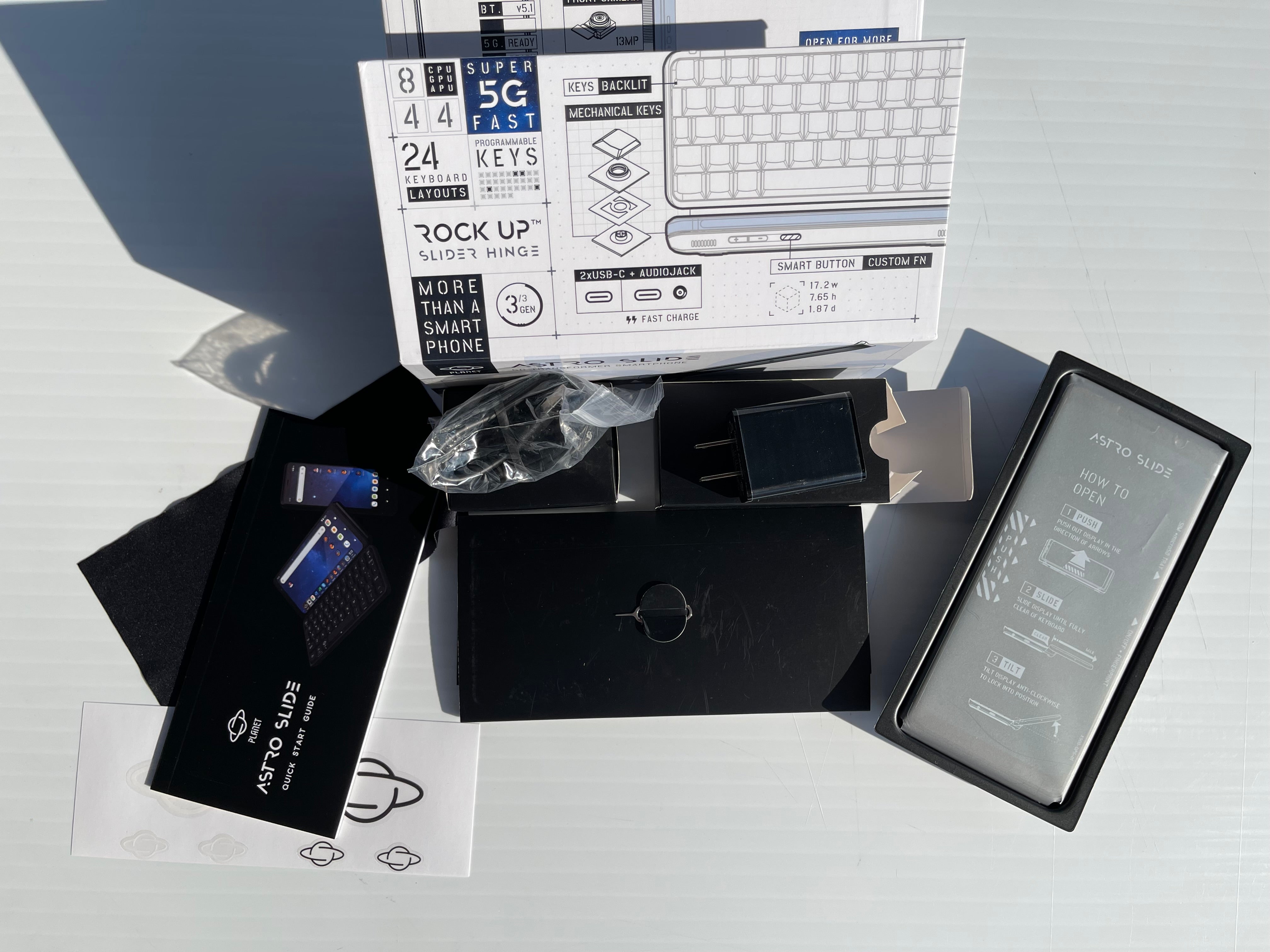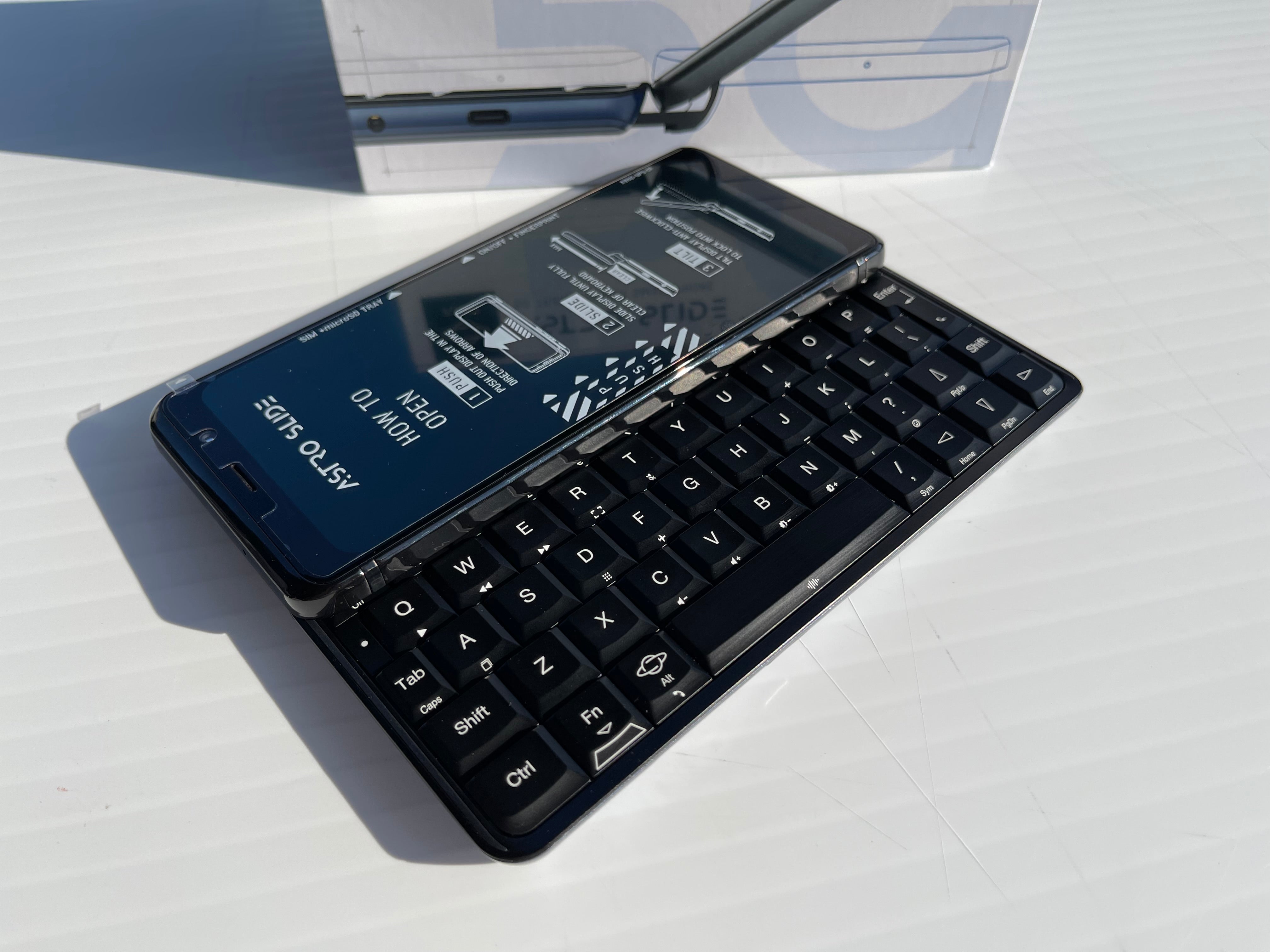After waiting for over 1 and a half years, we're finally receiving the Astro Slide 5G. Although officially releasing end of July (hopefully), Planet Computers has been sending out small batched units for testing and reviews.

The brand-new Astro Slide 5G operates uniquely. It still provides a laptop-Esque experience but raises the screen from the QWERTY keyboard using a sliding mechanism rather than a clamshell one. Android 11 comes with specialized apps, 5G capability, and a foundation of standard smartphone functionality.
The Astro Slide 5G is a bulky 18.7mm thick and weighs a substantial 325g while having a typical handset size of 172.4mm by 76.5mm. It has a black top and a deep blue base, making it clear that it is formed of two distinct portions. The absence of an IP rating for dust and water protection in the specs is clearly explained by this architecture.

Ports and connections are shared by the two portions. Two speaker grilles, a volume rocker, and a programmable button with long-press, short-press, and double-press functions are all located on one of the base's long sides. A 3.5mm headphone jack is located on one of the base's short sides, and both ends include USB-C ports.
OTG, video out, and charging are all supported on both USB-C ports. Only charging is native, though, so you'll also need a USB-C to HDMI converter for the other features.

It makes perfect sense to have the USB-C and headphone ports on the bottom area. The connections won't be lifted in the air like they would be if they were placed on the screen area and will instead sit level on a desk when the screen is tilted up for keyboard usage. On one lengthy edge of that upper half are the SIM slot and power button, the latter of which includes a fingerprint scanner.
A single 48MP camera is located on the underside, flat with the backplate rather than projecting like a lozenge. The Astro Slide 5G's single back camera is a blatant hint that photography is not its strongest point.

In its most recent design, the Cosmo Communicator, a tiny display was included inside the clamshell system's lid to address the requirement to display alarms and other information on the outside of the device. This time, the slide-and-tilt screen technology ensures that the screen is always visible, much as on a typical phone. This indicates that the screen is not shielded by the clamshell case; rather, Gorilla Glass 3 is used to cover it, which is somewhat less advanced than Gorilla Glass Victus.

With a 6.39-inch AMOLED display, FHD+ resolution is available (2,340 x 1,080 pixels, 403ppi). I thought the resolution was good and saw no problems with the text, video, or graphics. But the size of the bezels on the short edges pisses me off. These were 8 mm to the edge of the screen plate and a full 12 mm to the edge of the device, according to my measurements. This is obvious in the era of gadgets with small bezels. The bezels do give the selfie camera enough of an opportunity to reside outside the screen area rather than being incorporated into it.
There are two distinct movements needed to access the keyboard, and there is a certain beauty to it. The screen and keyboard components must first be separated. The left and right sides of the Astro Slide 5G are held in each hand, and a little push is made with the thumbs to accomplish this. The motion is smooth for the most part, although there is some resistance at the conclusion since a pair of hinges are also pushed outward from the base portion. The hinges won't move out if you're hanging on to the base too tightly with your fingers.

The second motion involves pushing the screen up from its rear border so that it tilts and rests on the two hinges, much like a laptop. After doing this a few times, using your fingers and thumbs to push and tilt the object becomes instinctive, quick, and fluid. The top and lower portions seem like they are going to separate company at that moment, four-fifths of the way through the push movement, right before the hinges deploy, even though they are fairly secure.
Even after doing it several times, I still thought that closing down was more of a two-stage procedure. I never did discover a way that was consistently quick and comfortable for releasing the hinges and then sliding the two portions together.

In laptop form, using the touch screen might be a bit annoying since, if you're not cautious, prods and sweeps practically everywhere—aside from approximately a centimetre from the connection to the base—cause the gadget to lurch backwards. Once I figured out a light-touch strategy, it was OK, but other people would find it difficult.
The Astro Slide 5G's illuminated keyboard is its main selling point. It is the ideal homage to the keyboard on the original Psion Series 5 since it has huge, physical keys that create a distinct "clack" when pushed. It will take some practice to master all of the shortcut key combinations, just like on that gadget, before you can fully utilize them. I found typing to be relaxing, and after a little finger-spread retraining, I was almost able to touch-type.

Due to its patented physical keyboard, whose slide-and-tilt access method is a little difficult to get used to, the Astro Slide 5G is thick and hefty for a smartphone. However, Planet Computers' companion applications are appealing and evocative of the Psion Series 5 from the late 1990s, which served as the model for this phone.
While there isn't much direct competition for the Astro Slide 5G, there are other devices, such as Bluetooth keyboards for phones and several tablet/keyboard combinations. The latter is larger and more cumbersome to carry, but they work better for prolonged periods of typing.

Planet Computers has successfully adapted the Psion Series 5 idea for the 5G age with the Astro Slide. It will be useful if you require a phone with a physical keyboard, but it won't likely cause a stir among the general public.





